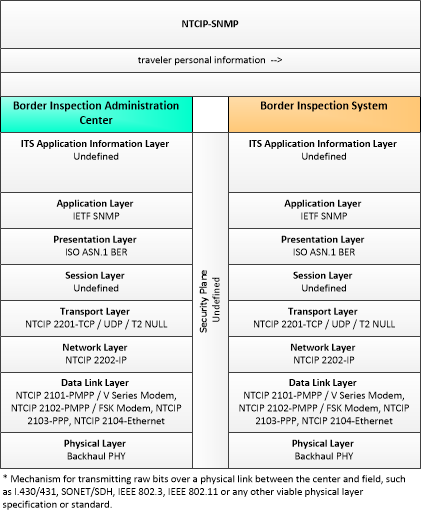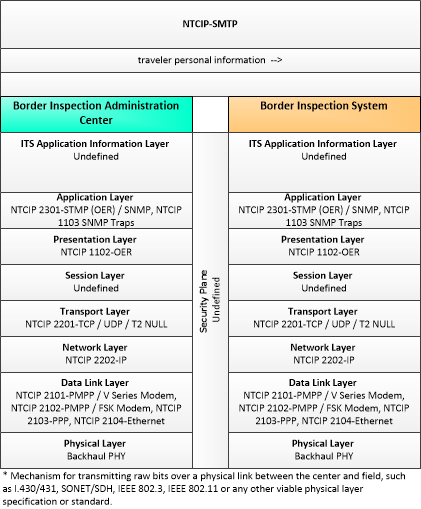Link Type: Center to Field
Border Inspection Administration Center --> Border Inspection System:
traveler personal information
Definitions
traveler personal information (Information Flow): This flow includes biometric and other data to allow recognition of travelers.
Border Inspection Administration Center (Source Physical Object): 'Border Inspection Administration Center' represents back-office systems and databases run by domestic and foreign governmental agencies responsible for the regulation of trade, and the enforcement of customs and immigration laws. These agencies include U.S. Department of Homeland Security (DHS) and its counterparts in Canada and Mexico. DHS includes components like Customs and Border Protection (CBP), Immigration and Customs Enforcement (ICE), and Transportation Security Administration (TSA). Other agencies include secondary trade agencies (e.g., U.S. Food and Drug Administration, U.S. Department of Agriculture, other USDOT departments, etc.), and agencies from other trading nations. The systems they manage coordinate activities related to the border crossings. These systems support import/export cargo processing and enforcement operations at the border, including programs such as FAST, Automated Commercial Environment (ACE), Nexus (Canada), SENTRI (Mexico), and US-VISIT.
Border Inspection System (Destination Physical Object): 'Border Inspection System' represents data systems used at the border for the inspection of people or goods. It supports immigration, customs (trade), agricultural, and FDA inspections as applicable. It includes sensors and surveillance systems to identify and classify drivers and their cargo as they approach a border crossing, the systems used to interface with the back-office administration systems and provide information on status of the crossing or events.
Included In
This Information Flow is in the following Applications:
This Information Flow is in the following Application Objects:
Communication Diagrams
The communication diagram(s) can be viewed in SVG or PNG format and the current format is SVG. Switch to PNG format.
This profile describes an alternative set of standards used to communicate with ITS Roadway Devices that uses the NTCIP Octet Encoding Rules (OER), a standard developed specifically for the transportation industry. This template is used primarily for communication with traffic signal controllers, where second-per-second communications is required. This template also includes standards for SNMP traps, that allows an ITS Roadway Device to initiate event-driven communications with a receiver.
Characteristics
Architectural:
| Characteristic | Value |
|---|---|
| Time Context | Recent |
| Spatial Context | Local |
| Acknowledgement | True |
| Cardinality | Unicast |
| Initiator | Destination |
Security
This information flow triple is in the following applications with the following security levels.
| Information Flow Security | |||||
|---|---|---|---|---|---|
| Application | Confidentiality | Integrity | Availability | ||
| Basis | Basis | Basis | |||
| Border Management Systems | Moderate | High | Moderate | ||
| This flow includes PII of travelers. If it also includes the necessary challenge questions and response to impersonate that individual, it could be classified as a HIGH. | False data here could allow someone to impersonate someone else. This may lead to an unauthorized person entering the country. | The system must have an acknowledgement of a missed message. If this data is not received, the traveler will have to identify themselves through the traditional methods, such as a passport. | |||

